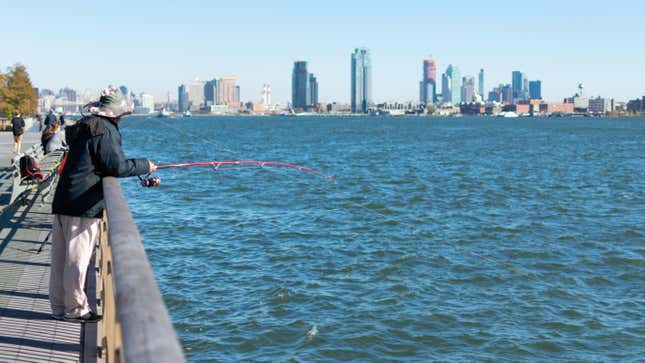
In 2020, around 55 million Americans went fishing. Over 80% of Americans live in urban areas. That adds up to a lot of city-fishing, whether it’s denizens of the Motor City dropping lines in the Detroit River, or Los Angeles anglers fly-fishing for “sewer salmon” in L.A.’s industrial trench of a river.
But can you actually eat fish you pull out of a city’s sludgy waterway and hope to survive? Surprisingly, sometimes you can—some urban waterways are about as clean as many rural waterways. This is not because urban rivers and lakes are particularly clean, but because rural waterways are often contaminated.
Pollution levels in urban waterways vary greatly
It’s easy to assume that all urban fishing should be strictly catch-and-release; city waterways just feel dirty. But feels can be deceiving. Despite the L.A. River’s postapocalyptic look, the water that trickles through its concrete channel is 90% outfall from water treatment plants. It’s treated wastewater, which sounds disgusting, but is actually heavily monitored and tested, and pretty clean (unlike the other 10% of L.A.’s river water.)
That peaceful country stream in Bumfuck, Montana, on the other hand, may look idyllic, but could be fed by agricultural runoff filled with pesticides, or could be just downstream from a chemical plant illegally pumping mercury into the water table. Bottom line: You cannot tell how polluted a body of water is by how it looks or whether it’s in an urban setting or not.
How to tell if the fish you catch is likely to be edible
Whether you’re fishing in the wilds of Alaska or in the East River in the Bronx, the contamination level of a body of water should be researched on a case-by-case basis. No fishing spot is ever completely safe. All freshwater-caught fish are potentially corrupted by modernity, but freshwater fish you catch yourself are particularly problematic. Whether you should eat them or not ultimately depends on your own tolerance for risk, but there are ways to mitigate that risk.
Check out the EPA’s list of fish advisories
The Environmental Protection Agency maintains a huge database of fish and shellfish advisories, dating back to 1974. The agency has collected advisories for fish and shellfish issued by federal, state, territorial, or tribal agencies all over the country and organized them by location. Before you chow down, do your research to see if a warning has already been issued.
Call your local or state environmental health department
The EPA’s database is a great place to start, but it’s not the final stop. There could be conditions and warnings that haven’t made it onto the EPA’s database, and not every body of water has been surveyed, so you have to drill down to a more local level.
Here is a list of state, territory and tribe fish advisories with contact information for each. Check out the websites and give them a call to ask them about local conditions where you want to fish. Also: You could try talking to the folks at the bait shop or the place you apply for your fishing license.
Look for advisory signs
If a waterway has been found to be contaminated or otherwise unsafe, there should be signs clearly expressing the potential dangers on shore. Look for them near fishing spots.
Choose younger fish
Because toxins and chemicals tend to build up over time, younger, smaller fish are more likely to be “cleaner” than older fish. If you’re going to eat one of your catches, make sure it’s a little one (provided it’s over the legal limit.)
Eat panfish instead of fatty fish
Panfish—freshwater fish that usually fit in a pan—are generally thought to be safer to eat than fatty fish like catfish or carp. Panfish feed largely on insects instead of bottom-feeding like their fatty friends, and that diet is lighter in pollution. Since substances can build up in a fish’s fat, less fat means less contamination.
Clean and cook your fish properly
Removing the head and skin of a fish is the obvious first step, but make sure you get rid of the fat and organs altogether—that’s where chemicals are likely to be concentrated most heavily.
When it comes to cooking, the best choices are to thoroughly bake, broil, or grill your fish. Frying may be the most delicious option, but it can seal chemical pollutants in with the fat.
As a general rule, let as much fat drain away as possible when cooking fish, and remember that the drippings you might use in a broth are higher in pollutants than other parts of the fish, so do this sparingly, or not at all.
The bottom line: You probably shouldn’t eat any fish you catch
To recap: To lessen the danger of eating freshwater fish, you have to do a lot of research and end up eating small, scrawny fish cooked in a way that makes them less tasty. If you’re thinking, “why even bother?” you’re on the right track.
According to a recent analysis of EPA fish-tissue research, basically every wild-caught fish in the United States is laden with PFAS (per- and polyfluoroalkyl substances). These “forever chemicals” are used in textiles, fire suppression foams, and other places, and have been building up in the environment since the 1940s. They are indestructible, and everywhere. On average, a freshwater fish caught in the US has a PFAS level 278 times higher than a commercially sold fish—those fish are usually caught far out to sea, so they’re at least somewhat cleaner.
And PFASs are only one kind of contamination. Fish can be contaminated with mercury, PCBs, PBDEs, dioxins, chlorinated pesticides, and bacteria of all kinds. You’re much better off going the catch-and-release route, then buying some fish at the supermarket.
